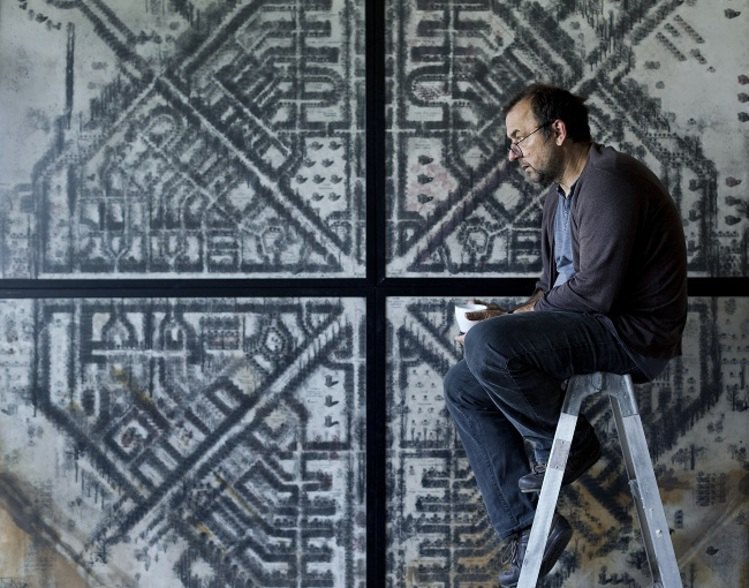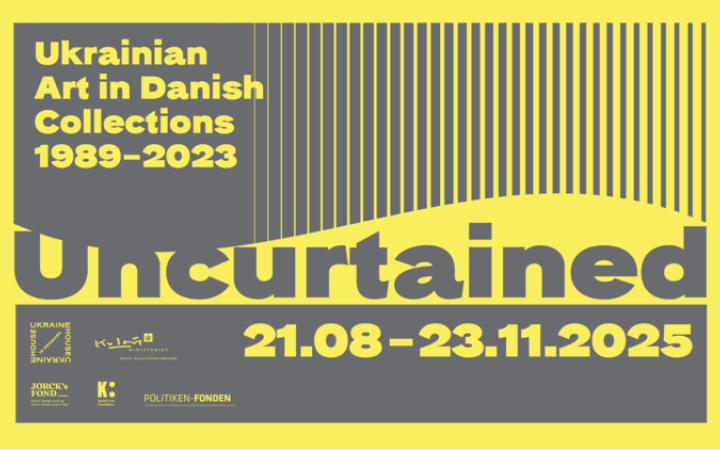The Ukrainian House in Denmark presents the exhibition ‘Uncurtained: Ukrainian Art in Danish Collections 1989–2023’, opening on 21 August 2025 in Copenhagen. This exhibition is a comprehensive project that, for the first time, systematically explores and presents the history of cultural ties between Denmark and Ukraine through the lens of visual art. Curator of the exhibition and of the Ukrainian House in Denmark, Kateryna Stukalova, has spent over two years compiling research material. Drawing on her deep knowledge of Ukrainian art processes in the 1990s, she was able to illuminate over 30 years of artistic dialogue between Ukraine and Denmark — long before Russia’s full-scale invasion.
In February 2023, the Danish Ministry of Culture allocated the former Gammel Dok Architecture Centre in central Copenhagen to house the Ukrainian House. This gesture signified unprecedented political and cultural support for Ukraine from Denmark. Over the course of three years, the Ukrainian House has hosted ten exhibition projects dedicated to Ukrainian contemporary art, architecture, design, and photography. Uncurtained is the eleventh exhibition — and also a culmination of the institution’s work, offering insight into the roots of cultural solidarity between Ukraine and Denmark.
“Our eleventh exhibition, Uncurtained: Ukrainian Art in Danish Collections 1989–2023, is both an expression of gratitude and an act of recognition. It honours the Danish curators, collectors, and institutions that believed in Ukrainian art long before the world fully grasped what was at stake. The exhibition unveils decades of cultural dialogue that began well before the current political partnership between Denmark and Ukraine. At the Ukrainian House, we believe cultural exchange is not a luxury — it is the strongest foundation of shared security. Uncurtained declares that Denmark’s investment in Ukraine began not only with weapons or political support, but — quietly — with trust in Ukrainian creativity. Art, therefore, may have become the starting point of the Danish model of solidarity. For a Ukrainian audience, this exhibition is an important act of self-reflection. It documents the emergence of Ukraine’s artistic voice in the years after independence and affirms the autonomy of our culture, so often overshadowed by loud imperial narratives. For a Danish audience, Uncurtained offers a rare opportunity to fill a gap in collective memory — to decolonise perception and see Ukrainian art not as some neighbouring exoticism, but as an integral part of the European cultural landscape. This is not merely a story of solidarity — it is a recognition of shared heritage,” says Nataliya Popovych, head of the Ukrainian House in Denmark.
The exhibition title Uncurtained refers to the fall of the Iron Curtain in 1989 — a moment that opened new channels of cultural dialogue between East and West. It also symbolically points to how, after decades in private collections, these works are now being brought into public view, enriching and reinterpreting an essential chapter in the history of Ukrainian art. Uncurtained also reflects how the West continues to ‘rediscover’ Ukraine — during the fall of the USSR, after the Revolution of Dignity, and in the context of Russia’s full-scale war against Ukraine.
“Through the prism of visual art, the exhibition traces the history of Europe’s geopolitical shifts over recent decades, highlighting Ukraine’s vital place in the continent’s cultural and political landscape. It dismantles inherited narratives that have long shaped the telling of Ukrainian art history, many of which remain insufficiently questioned. These narratives often exaggerated the influence of Moscow-based institutions and figures on Ukrainian art in the late 1980s, while marginalising or overlooking the role of decentralised artistic collaboration — particularly in the Baltic and Northern European contexts. This exhibition seeks to restore fair historical interpretations and draw attention to a less intensive yet significant and little-known cultural dialogue between Denmark and Ukraine throughout the 2000s and 2010s,” says curator Kateryna Stukalova.
Uncurtained will showcase works by some of Ukraine’s most influential artists, including Pavlo Makov, participant of the 59th Venice Biennale (2022), laureate of the Taras Shevchenko National Prize, and member of the UK’s Royal Society of Painter-Printmakers. His works are held in such collections as the National Gallery of Art (Washington), the Victoria and Albert Museum (London), and the Museo Thyssen-Bornemisza (Madrid). As early as the 1990s, Makov established professional connections in Denmark, including with Fyns Grafiske Værksted in Odense, where he created a number of key graphic works. Today, he continues to work in front-line Kharkiv.

Another prominent figure featured in the exhibition is Serhiy Svyatchenko — a Ukrainian artist who has lived and worked in Viborg since 1990. His works have become part of Denmark’s contemporary cultural landscape, and he is known for his innovative approach to abstract collage and visual architecture. His art is held in numerous public and private collections across Denmark. In 2024, together with Yehor Zihura, he created the sculpture Hope for the sculpture park KunstCentret Silkeborg Bad. His name has come to symbolise the enduring and fruitful cultural dialogue between Ukraine and Denmark.
The exhibition also includes works by designer Oleksiy Iskos, a native of Kharkiv who has lived in Copenhagen for many years. He has collaborated with renowned Scandinavian brands such as Muuto, Hay, and Normann Copenhagen. In 2023, in collaboration with the Ukrainian company ZAVOD, he created the REAL TIME clock, which was showcased at the exhibition Material Resistance: Ukrainian Design in Action at the Ukrainian House in Denmark as part of the 3daysofdesign 2025 festival.
Other participating artists in Uncurtained include: Valentyn Rayevskyy, Valentyn Khrushch, Martynchyks, Yuriy Solomko, Yuriy Leyderman, Oleh Tistol, Maryna Skuharyeva, Yana Bystrova, Oleksandr Lutskevych, Yevhen Prokopov, Yuliya Byelyayeva, Mariya Kulikovska, Mykyta Shalennyy, Olena Subach and Vyacheslav Polyakov, Julie Poly, Sasha Maslov, Yevhen Nikiforov, Kinder Album, Lyusya Ivanova, Kateryna Svirhunenko, Iryna Hvozdyk, Anastasiya Nesterova, Nelli Isupova, and Yanina Myronova. They represent different generations of Ukrainian art and a wide range of media: from painting and sculpture to photography and virtual reality.
The artworks for the exhibition have been provided by public, corporate, and private collections, including: the Design Museum, KunstCentret Silkeborg Bad, Odense Kommune, Fyns Grafiske Værksted, Guldagergaard International Ceramic Research Center, Jyske Bank, Henrik Nielsen, Jens and Masha Faurschou, Sergei Sviatchenko, Maria Rytter, Ulla Lundberg, Villy Petersen, Per Nørhaven, Lis Janstrup and Jens Gregersen, Jørn Jacobsen, Jesper Blædsild, and Helena Tomasson.
A printed catalogue will accompany the exhibition, featuring unique materials gathered from archives in both Ukraine and Denmark.
The exhibition will run from 21 August to 23 November 2025 at the Ukrainian House in Denmark, located at Gammel Dok, Strandgade 27B, 1401, Copenhagen.










